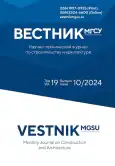Введение. С уходом иностранных компаний с российского рынка появилась необходимость в химических анкерах отечественного производства. Исследованы свойства первого полностью отечественного химического анкера UТECH HITRE500 на основе эпоксидной смолы.Материалы и методы. Температура стеклования определялась по ГОСТ 32618.2–2014 на приборе ТМА Q400, прочность при изгибе — по ГОСТ 4648–2014, прочность при сжатии — по ГОСТ 4651–2014, прочность сцепления клеевого состава с бетоном — по ГОСТ Р 58387–2019 при помощи испытательной машины Instron 3382.Результаты. Установлены такие характеристики химического анкера, как температура стеклования, прочность при изгибе, модуль упругости при изгибе, прочность при сжатии, сопротивление сцепления при вырыве при температурах эксплуатации: +23, +42, +70, –60 °С, а также время, за которое химический анкер набирает 97,7 % прочности на вырыв при твердении при температуре воздуха –10 °С (10 сут). Определено, что при выдерживании образцов, твердевших в течение 1 сут при комнатной температуре, при температурах +42 и +70 °С происходит значительное снижение прочности сцепления при вырыве (на 29,7 и 64,7 % соответственно). При выдерживании образцов, твердевших в течение 1 сут при комнатной температуре, при температуре –60 °С прочность на вырыв незначительно увеличилась по сравнению с контрольными образцами (на 4,6 %).Выводы. Приведены результаты испытаний первого полностью отечественного химического анкера UTECH HITRE500. Определены температура стеклования и физико-механические свойства отвержденного химического анкера. Установлено время, необходимое для набора прочности в условиях отрицательной температуры –10 °С, равное 10 сут.
 1591-1605
1591-1605


 1606-1616
1606-1616


 1617-1628
1617-1628


 1629-1640
1629-1640


 1641-1650
1641-1650


 1651-1665
1651-1665


 1666-1675
1666-1675


 1676-1686
1676-1686


 1687-1695
1687-1695


 1696-1712
1696-1712







